Finding the best ecommerce platform for your online store can be a lengthy process. With so many on the market, all promising essentially the same thing, with slightly differing USPs, it’s hard to know where to start or what to look for.
That’s why we’re comparing three of the bigger-named ecommerce platforms: Shopify, BigCommerce and Square Online. This comparison review aims to provide enough detail so that, hopefully, by the end, you’ll know which (if any) suit your needs.
But, in case you don't have time to trawl through this entire review, here's the bottom line:
Quick Overview
Choosing between these three ecommerce platforms is challenging. Each offers something regarding its features, pricing, templates, customer service, SEO tools, and more. In addition, each allows you to list and sell unlimited products across all pricing plans.
That said, Square Online has a free plan that may be a great choice if you’re a small business. In contrast, Shopify and BigCommerce offer more functionality, such as in-built blogging functionality and more templates to choose from.
However, if I was forced to crown a winner, it would be Shopify. It’s simple to use, affordable, boasts first-rate customer support, and is consistently well-reviewed. Not just that, but you can have a fully-functioning ecommerce store up and running within minutes for just $1/mo for the first three months (at the time of writing).
Now that I’ve got the preamble out of the way, let’s dig into the meat and potatoes of this comparison review:
In this article:
Features
First and foremost, you’ll need to ensure the ecommerce platform you plump for boasts all the features you need.
Shopify, BigCommerce, and Square Online’s features are all accessible from a single dashboard, including account management, recent orders, billing information, and more.
With that said, below is a more detailed look at Shopify, BigCommerce, and Square Online's features. Unfortunately, we can’t cover every feature these platforms offer, so we’ll just touch on their core functionalities:
Shopify’s Features
Compared to its competitors, Shopify offers a LOT of simple-to-use features. You don’t need coding experience to build your store. In fact, theoretically, you could have your online shop up and running within hours, if not minutes.
Let's explore Shopify’s core features in greater depth:
Web Hosting
Shopify is a self-hosted platform, so you don’t need to worry about sourcing web hosting. You also benefit from unlimited bandwidth and automatic Shopify platform updates.
Dashboard and Product Listings
You can view everything you need from your Shopify dashboard to run your store. This includes order numbers, sales metrics (such as a breakdown of where your sales have come from (online store, Facebook, in-store)), account management features, order details (order numbers, fulfilled and unfulfilled orders, and unpaid orders), customer data, and more.
You can also add products (physical and digital) from your dashboard, which is super easy. Each time you add a product, you fill out each designated field, including the product’s name, price, description, and image.
You can also import products from a CSV file. Best of all, there’s no limit to how many products you can sell (regardless of your pricing plan).
Shopify Storefront
There are 120 professionally designed themes you can customize using Shopify’s intuitive website builder. Of these themes, 11 are free, and 109 have a price tag. You can personalize everything from fonts, colors, layout, and imagery with simple drag-and-drop sections. You can also add third-party and Shopify apps, widgets, and integrations, such as blogs, product recommendations, etc., to enhance your storefront.
MultiChannel Selling
Shopify offers robust multichannel selling capabilities, with the ability to sell products on online marketplaces like Amazon, eBay, and Walmart, as well as social media platforms like Facebook, Instagram, and Pinterest, while using Shopify to consolidate and track all this data from your dashboard.
Security
You receive a free SSL certificate that attests to your website’s authenticity and encrypts your customer's data to keep it secure. You’re also level 1 PCI security compliant. All users can also access two-step authentication to protect themselves against fraudulent transactions. You can also receive notifications if someone unauthorized accesses your account.
Shopping Cart
Choose from 100+ payment processors, including Shopify’s native payment gateway, Shopify Payments. If you opt for the latter, you won’t be charged additional transaction fees (the same can’t be said if you use third-party payment gateways).
Order Fulfillment and Shipping
You can buy and print discounted shipping labels from Shopify and display real-time shipping rates instead of flat rates. You can also access order tracking, monitor inventory levels, and more within your dashboard.
In the US, Shopify works alongside the following shipping carriers: USPS, UPS, and DHL Express.
Lastly, you can use Shopify’s Fulfillment Network (SFN). This fulfillment service stores your inventory picks and packs your products, and ships them to customers (primarily within two days in the US). There are extra fees associated with this service. However, Shopify doesn’t clarify these costs, so we recommend contacting them directly for more accurate pricing information.
Analytics
All Shopify plans include reports on analytics, finances, and product analytics, giving you information on your product performance over the past 90 days. However, you'll need to upgrade to the Shopify plan to unlock extra reporting functionality like order, sales, retail, profit, and customer reports. It’s also worth noting that only Advanced Shopify users can access custom reports.
Marketing
Where marketing is, you benefit from the following tools:
- You can offer percentage and money-off discounts.
- You can sell on Facebook.
- You can create marketing automations; for example, Shopify’s built-in email functionality allows you to send automated welcome emails, winbacks, and upsells based on ready-to-use templates.
- Flash sales
- A built-in blog
…and more (we’ll elaborate on its SEO tools below).
Customer Accounts
You can allow customers to create accounts on your store, from which they can view their orders and profile information. They can also log in to their account to checkout faster. Your store’s theme and branding automatically apply to your customer accounts page.
Mobile App
You can manage your Shopify store from the convenience of a mobile app, including inventory management and order fulfillment.
BigCommerce Features
Like Shopify, BigCommerce has tons of in-built features and boasts unlimited bandwidth. You can also list and sell limitless products on all plans.
On top of that, some of its most notable hallmarks include:
Dashboard
As I previously mentioned, your BigCommerce dashboard is where you manage your online store. So, for example, you can:
- View orders
- View products with low stock.
- Oversee store performance metrics for the current day, week, month, or year, including total order numbers and from how many customers, recent orders, and much more.
You can customize your dashboard according to your needs to show or hide sections pertinent to your business.
Storefront Design
When customizing your online store, you can use BigCommerce’s website builder (no coding needed), or if you have the coding smarts, you can access the HTML and CSS to fully adapt your design.
It’s also worth noting that your BigCommerce checkout page is also customizable. BigCommerce’s page builder allows you to define new fields without any coding. You can also use BigCommerce’s Checkout API to make more significant modifications to the checkout. This is an improvement on Shopify, which only allows you to edit its checkout on Shopify Plus (its enterprise plan).
Marketing and SEO
Among other things, BigCommerce offers the following in-built marketing tools:
- Sell via social media such as Facebook and Instagram.
- Create a blog
- Provide segmented customer pricing.
- One-click integration with Google Shopping
- Customers can leave ratings and reviews.
- Abandoned cart recovery
- You can create discounts and promotions to entice customers.
- You can offer custom product recommendations based on customer behavior.
Customer Accounts
Like Shopify, customers can create an account on your BigCommerce website. From here, shoppers can manage their orders, settings, and returns and create wish lists (Shopify, in comparison, doesn’t have an in-built wishlist function).
You can also add store credit to your customer's accounts, which they can review once logged in.
You can activate BigCommerce’s customer account functionality by entering your display settings in your BigComemrce dashboard and enabling account creation.
MultiChannel Selling
BigCommerce offers a wide range of multichannel selling capabilities, including integration with online marketplaces like Amazon, eBay, and Sears and social media platforms like Facebook, Instagram, and Pinterest. Like Shopify, you can centralize your sales efforts and sync your inventory for precise tracking and analytics.
Payment Gateways
BigCommerce supports multiple digital wallets, including Google Pay, Amazon Pay, Apple Pay, PayPal One Touch, and more. In addition, BigCommerce works alongside 55+ payment providers and doesn't charge transaction fees.
Shipping
You’ll receive real-time shipping quotes from USPS, UPS, FedEx, Australia Post, Canada Post, and more. You can also set up free customer shipping or offer a flat fee.
Order Fulfillment
BigCommerce integrates with a range of shipping and fulfillment integrations, such as Fulfillrite. In this instance, you can send your stock to its fulfillment centers, and it will pick, pack, and ship each order on your behalf.
Square Online Features
Like BigCommerce and Shopify, Square Online users can sell products via a Square Online website, Facebook, and in person. That said, let’s take a broader look at the platform’s features:
Dashboard and Analytics
As I mentioned, you can manage your entire store from Square Online’s easy-to-view dashboard. Here you’ll see gross sales, transaction numbers, how much you’ve taken in sales, how customers have paid, real-time sales reports, which items sell the most, and more.
Store Setup
You can launch a mobile-friendly site using Square Online’s drag-and-drop editor in minutes. The website editor lets you personalize your store’s colors, content, and functionality with just a few clicks.
There’s also a new feature called Photo Studio which allows you to take product photos using your phone, automatically remove backgrounds, and update your catalog while on the go.
Customer Accounts and Store Browsing
You can highlight new products, special offers, best-selling products, etc. On top of that, repeat customers can view their previous orders via their customer account and reorder (should they wish).
You can easily enable customer accounts in your settings. Once activated, the customer account page is automatically populated and styled according to the rest of your website design.
Delivery
You can offer customers various delivery options, including local delivery powered by your in-house staff, free click-and-collect, and order delivery.
You can set delivery rates based on product prices, the number of items in an order, and the order weight, or you can charge a flat rate delivery fee.
Payment Methods
Square Online prefers users to rely on Square’s own payment gateway, which also syncs perfectly with its POS. The downside is that they don’t have a lot of other payment methods available.
You can accept all major credit cards via Square Pay, Google Pay, Samsung Pay, and Apple Pay. On top of that, you can give customers the option to ‘buy now, pay later’ with ClearPay.
Marketing
Square Online offers the following built-in marketing tools:
- Email marketing enables you to send targeted emails to specific customer types. For example, lapsed customers, new customers, and regular customers. You can view email click-through rates via your dashboard.
- The ability to create and offer shopper discounts and vouchers. You can view the number of redemptions of these in your dashboard.
- You can launch a customer loyalty program that rewards shoppers with redeemable points and discounts when they spend in-store or online. Customers can register their participation at checkout, and you can track how much revenue your loyalty program has generated (there is an additional cost for this service, starting at $45 a month).
- You can sell virtual and physical gift cards – all gift card sales are tracked.
Blog and Multichannel Selling
Square Online doesn't offer an in-built blogging platform, unlike the other platforms in this review. It also doesn’t provide much multichannel selling functionality – however, you could workaround this using its Zapier integration.
Templates and Designs
You’ll be pleased to hear that all three platforms have a selection of free and paid-for templates. For the uninitiated, an online store theme or template is a pre-designed layout that sets the framework for your online store's design.
With that in mind, let’s explore what Shopify, BigCommerce, and Square Online all have to offer in this regard:
Shopify’s Templates and Designs
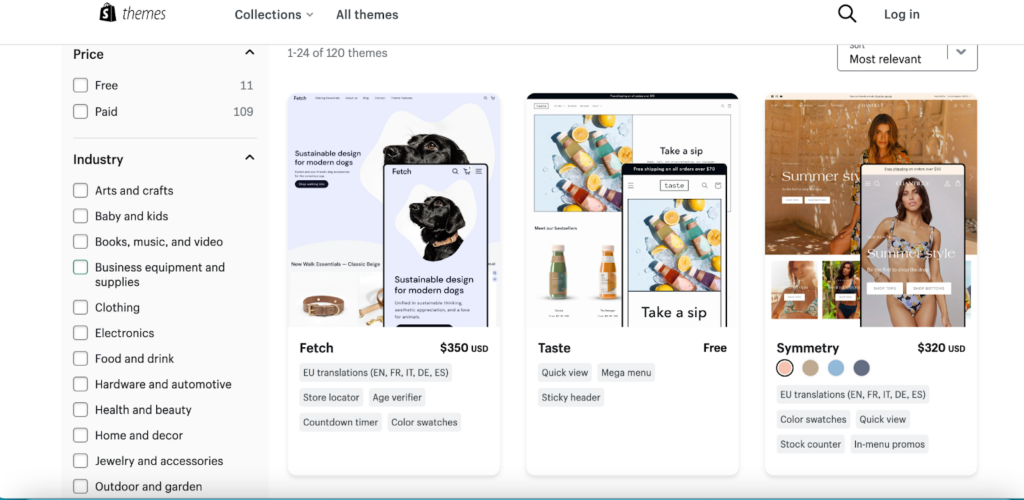
Shopify offers its users a selection of 100+ mobile-friendly templates and designs with built-in SEO (such as automatic sitemaps and editable metadata). Some are free (11), and others (109) are paid for, with prices ranging between $180 and $350. They are all customizable, beautifully designed, and contemporary. Templates and organized into various categories, including books, music videos, home and decor, health and beauty, etc., which you can filter to find the templates that best suit your needs.
BigCommerce’s Templates and Designs
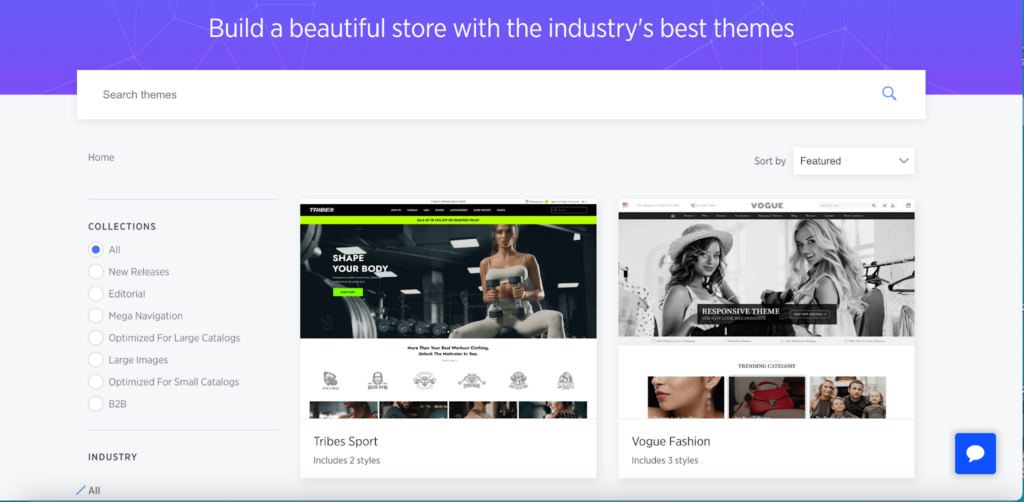
BigCommerce is more generous than Shopify when it comes to templates. BigCommerce offers customers hundreds of themes. There are 286 to choose from. Like Shopify, they come in various categories, including arts and crafts, home and garden, health and beauty, fashion, and jewelry. There are 15 free templates, and the remaining ones are paid for; prices range from $150 to $399.
Like Shopify, you can filter through BigCommerce’s themes by which collection they fall under, such as editorial, optimized for large catalogs, B2B, large images, and more.
Again, these themes are customizable, well-designed, and provide ample space to position text and images. They’re also mobile-friendly and have built-in SEO (for instance, BigCommerce automatically adds SEO-friendly URLs to your pages, rich snippets, and redirects).
Square Online Templates and Designs

Unlike Shopify and BigCommerce, Square Online doesn’t have a theme library. Instead, you can choose from various popular styles when setting up your store. For example, you’re offered a choice of preferred colors (15 in total) and five theme styles (Minimal, Soft, Bright, Bold, and Midnight).
If you’re not happy with the colors presented, you can create your own customized pallet. It’s also possible to apply custom styling to specific sections and elements.
Square Online’s styles look clean, professional, and attractive, with plenty of white space.
Pricing Plans
Irrespective of whether you’re a well-established eCommerce owner with a reasonable budget or just starting out, the last thing you need is for a large chunk of your costs to be swallowed up by hefty eCommerce platform prices.
So how do Shopify, BigCommerce, and Square Online compare in terms of pricing?
Let’s look at each in turn:
Shopify Pricing
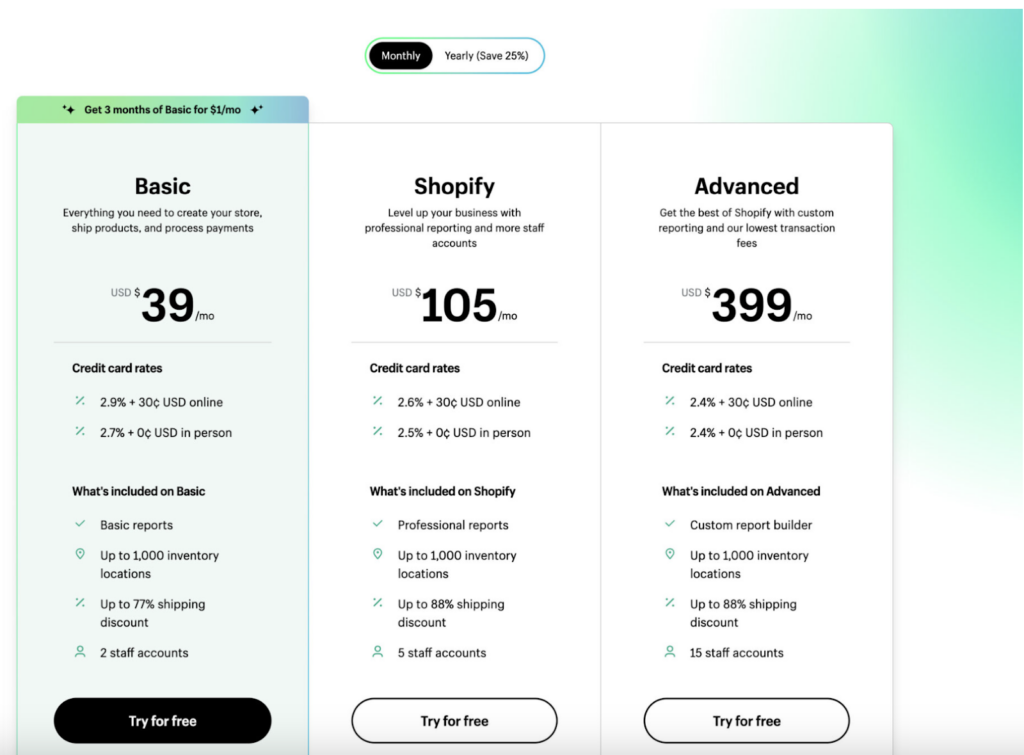
You can try before you buy with a free three-day trial. After that, you’ll have to pick a paid-for pricing plan. However, at the time of writing, you can enjoy three months of Shopify for $1/month when you sign up for a monthly Starter or Basic program.
Alternatively, if you pay annually, the fees are 25% less.
That said, below, I’ve listed the cost of Shopify’s pricing plans:
- Shopify Starter: $9/mo
- Shopify Basic: $29/mo if you pay annually, or $39/mo if you pay monthly
- Shopify: $79/mo if you pay annually, or $105/mo if you pay monthly
- Advanced Shopify: $299/mo if you pay annually, or $399/mo if you pay annually
BigCommerce Pricing
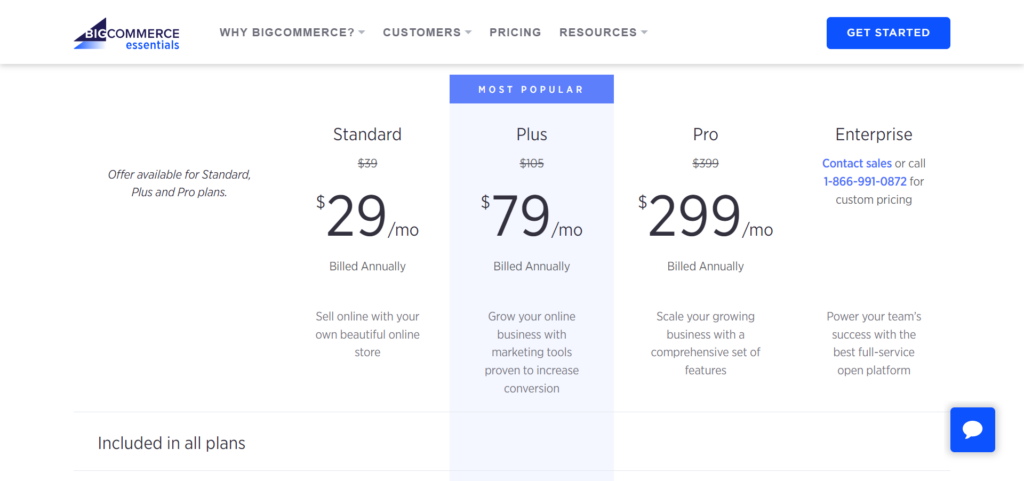
There’s a free 15-day trial. After that, you can choose whichever pricing plan best suits your needs.
There are four options:
- Standard: $29.95/mo, irrespective of whether you pay monthly or annually
- Plus: $79.95/mo if you pay monthly, or $71.95/mo if you pay annually
- Pro: $299.95/mo if you pay monthly, or 269.96/mo if you pay annually
- Enterprise: you’ll have to contact the BigCommerce sales team for a custom quote
Square Online Pricing
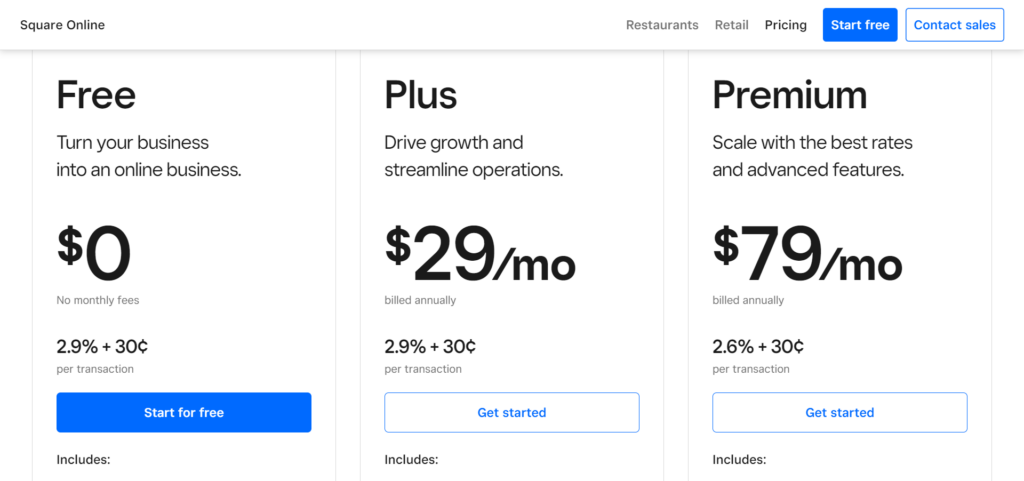
Square Online offers an entirely free plan, where you only have to shell out for payment processing fees when a customer makes a transaction on your store. If you use Square Online’s native payment gateway, rates start at 2.9% + 30 cents for online payments and 2.6% + 10 cents for in-person payments.
However, suppose you’re after a bit more than just the basic functionalities. In that case, there are the following paid-for plans to choose from (please note: there were no prices quoted for paying monthly):
- Plus: $29/mo billed annually
- Premium: $79/mo billed annually
On the Premium plan, online transaction fees go down to 2.6% + 30 cents.
Who Offers The Best Value For Money?
Square Online offers the cheapest plan available. It’s free. After that, we’re looking at Shopify Starter. However, both come with feature restrictions. For example, with Square Online’s free plan, you can’t remove its branding. Also, Shopify Starter doesn’t include an online store. Instead, this pricing plan only enables you to sell on existing websites via a buy button and social media platforms. So, to create a fully-fledged stand-alone store, you’ll need at least the Basic Shopify plan.
All three plans offer free trials, but Shopify’s was just three days at the time of writing. In contrast, BigCommerce's was 15, and Square Online has a free forever plan (but no free trial that we could see for their paid-for programs).
However, before determining which platform is the best value, you’ll need to list what functions you need and then look at the prices to determine the best deal for your needs.
That said, I think, given that the basic paid plans across all three platforms start at roughly the same price, and based on the features alone, I’d be inclined to go with Shopify. Its breadth and accessibility of features are excellent, making it easy to set up as a newbie online store owner.
However, for more advanced stores, BigCommerce may be a better choice in terms of its flexibility and scalability. It handles multiple currencies more intuitively, has more B2B features, and allows for more advanced checkout customization.
Apps and Add-Ons
All three platforms offer apps and add-ons:
Shopify
The Shopify App Store has plenty to offer ecommerce store owners looking to extend Shopify’s base functionality. Apps are categorized into marketing and conversion, product sourcing, store design, and reporting.
There are over 8,000 apps and add-ons. However, Shopify doesn’t list which are free to install, which come with a free plan or trial, and which come with a price tag from the get-go.
BigCommerce
BigCommerce also offers an extensive choice of apps and add-ons (1,245) that fall under various categories, including checkout, analytics and reporting, product sourcing, and more. Some apps are free, some come with just a free trial/or a limited free plan, and others need paying for immediately.
Square Online
Like Shopify and BigCommerce, the Square App Marketplace offers apps and add-ons across various categories, including accounting and tax, marketing and analytics, eCommerce, and many more. There are 127 apps and add-ons, much fewer than the above two platforms.
Popular apps listed include Xero, Wix, WooCommerce, and MailChimp. Unlike Shopify and BigCommerce, you can filter the apps when searching to view free, paid, or paid with a free trial.
Customer Support
At some point, you'll likely need help from your eCommerce platform. So, let’s look at how Shopify, BigCommerce, and Square Online compare in this area.
Shopify
Shopify offers its customers lots of support. Users across all its plans benefit from 24/7 live chat and phone support. You’ll also find plenty of self-help documentation in Shopify’s Help Center. You’ll find articles, webinars, and more on various topics such as payments, products, domains, etc. On top of that, there’s the Shopify Community, where you can access potential help from the platform’s 900,000 merchants and partners.
BigCommerce
BigCommerce offers 24/7 live chat and (US) phone support across all its plans. It also provides email support for all plan subscribers. There’s also an online Resource Center where you’ll find podcasts, webinars, an eCommerce blog, the BigCommerce community, and the BigCommerce University.
The BigCommerce Community is an online forum where BigCommerce users can connect and collaborate with each other. BigComemrce University is an online resource center that provides access to a wide range of in-depth training materials, including webinars, articles, and videos.
Square Online
Square Online also offers similar support to Shopify and BigCommerce – however, it’s not 24/7. First, you can contact them via its automated support assistant. You can also access support via phone, email, and social media (9 am to 5pm, Mon to Fri).
There’s also its Seller Community, where you can ask community members questions and attend seller events. Plus, videos and an online resource center is available, where you’ll find articles on various topics, including POS, analytics, getting started, and more.
Best for SEO
There’s little point in setting up an online store/website if no one can find it. That’s why SEO is so integral to this entire process.
Let’s take a look at what each platform offers in turn:
Shopify SEO
Shopify’s built-in SEO features help you optimize your store’s content. For example, you can edit meta descriptions, title tags, web page URLs (including blog posts and product pages), etc. You can also edit captions for images.
In addition, the Shopify App Store has a choice of 56 speed optimizer apps, 66 pages redirect apps, and 14 sitemap building apps to help you optimize your SEO.
In addition, Shopify has published blog posts explaining everything you need to know about SEO. There are also posts in the seller community on the topic and guidance in the Help Center. Lastly, on Shopify’s website, you can also subscribe to receive videos on SEO optimization.
Further reading 📚
BigCommerce SEO
BigCommerce offers ten apps to help you with SEO. Its Resource Center also has a fulsome guide on the topic, covering how to get started, keywords, the technical aspects of SEO, and much more. In addition, it has a helpful checklist covering all the necessary steps.
As for BigCommerce’s in-built SEO features, the platform boasts optimized URLs that you can edit, microdata (a type of structured data that can be added to a web page's HTML code to provide search engines additional information about the content on the page.), 301 redirects and URL rewrites, and automatic redirects. BigCommerce is also built on Google’s Cloud Platform and supported by Cloudflare’s global network; these work together to ensure your site loads quickly, which, as you probably already know, positively impacts your SEO. You can also up your content marketing game with BigCommerce’s built-in blog.
Square Online SEO
Square Online offers SEO tools across all its plans. You can optimize your website’s SEO via the Square Online Overview page found in your dashboard. This includes indexing individual pages and verifying your site with search engines, for example, Google with Google Search Console. You can also add ALT text to your images and add metadata such as titles and descriptions to your pages.
Square Online also offers an Ultimate SEO Guide that walks you through all the stages of getting started with SEO.
Which is The Best Ecommerce Platform For Your Business (including Dropshipping)
That’s pretty much everything we need to cover when comparing Shopify vs BigCommerce vs Square Online. Of course, each has pros and cons, which I’m sure have become apparent as you’ve read this comparison review.
Which is best for your business depends on you and what you need regarding functionality.
So below, let’s examine a few use cases:
Best for Dropshipping
If you’re hoping to launch a dropshipping business, you’ll want your chosen platform to make this as easy as possible.
Shopify
There are many dropshipping apps available in their app store, including AliExpress, Alibaba, Spocket, and a further ten suppliers. You’ll also find inventory management tools to help you sell across multiple channels and various apps to support a wide range of payment and shipping options.
BigCommerce
Like Shopify, BigCommerce integrates with various dropshipping services, including Alibaba, Spocket, Printful, and several other dropshipping suppliers. But, unlike Shopify, BigCommerce’s Help Center doesn’t offer detailed information on the topic. However, it provides multi-inventory and location support for setting up cross-channel selling and management.
Square Online
There are a few dropshipping integrations available in Square Online’s app market. These include Printful, Spocket, and ShopFlex. But, they don’t have any features specific for dropshippers, as their inventory manager doesn’t currently support drop shipping.
However, again, you can look to their app market to find inventory management apps to supplement any functionality that might be missing.
The Winner: Shopify
I think Shopify comes out on top here. Although it doesn’t have the most extensive list of dropshipping plugins (that’s BigCommerce), it offers more guidance and suggests suppliers worth investigating.
Best for SEO
All three platforms offer robust SEO, but Square Online doesn’t provide an in-built blogging engine. BigCommerce and Shopify are close rivals here because both offer out-of-the-box SEO tools.
However, overall, it seems that BigCommerce offers more advanced SEO features and tools than Shopify. For instance, BigCommerce offers microdata, 301 redirects, URL rewrites, and automatic redirects. While Shopify does have apps that support this functionality, it seems simpler with BigCommerce.
The Winner: BigCommerce
Best for Small Businesses
This one’s a more challenging call. All three offer affordable plans (free in the case of Square Online), and all three provide unlimited products.
Shopify, for example, offers the best all-around range of apps. In contrast, Square Online is clearly the most affordable. As for BigCommerce, it’s worth noting it’s suitable for multichannel selling.
The Winner: No Overall Winner
Best for Retail
Suppose you’re already a brick-and-mortar store owner or plan to open one alongside your online offering. In that case, you might want to know which of these three platforms will best support both your online and offline endeavors.
Shopify offers a free POS system that allows you to take payments in person via your phone, tablet, or a customizable POS terminal. It also unifies your online and offline sales data and inventory so customers can seamlessly buy offline and online from your store.
BigCommerce doesn’t have its own POS solution. Still, it does make it easy to sync your online and offline sales efforts by offering a variety of POS integrations, including PayPal, Zettle, Square, Vend, Clover, and more.
In contrast, Square Online offers its own POS software, including more specific tools for restaurants, appointments, and retail. The software is free but incurs the in-person transaction fees covered in the pricing section. Square’s POS syncs seamlessly with your online store and allows you to manage your entire business from one place.
The Winner: Square
Out of the three, Square is the most dedicated to the retail experience and offers the best in-person payment processing.
Best for Start-Ups
If you’ve never run an eCommerce business, you’re likely looking for the easiest and most affordable one. Our choice here is Square Online because it has a free plan that offers you enough features to get going, and the store setup is simple. However, from what I can see, the migration process is quite tricky. Migration often requires you to rebuild your store and import your products and inventory from scratch. So, if you think your store will snowball, it might be easier, in the long run, to go with Shopify from the get-go.
The Winner: Square Online
Further reading 📚
My Final Verdict
We’re finally at the end of my comparison. So, which platform do I think is the best? There are thousands of words to be found online on this topic, and each review site will give you a different answer for different reasons.
In the end, it’s your decision. Only you know what you need from your ecommerce platform and what you may require as you grow your business.
However, if I had to choose, I’d select Shopify over the other two. Yes, BigCommerce has decent SEO tools and impressive scalability. Yes, Square Online offers a free program with unlimited products. Still, I think Shopify takes the edge thanks to its fulsome feature list, ease of use, award-winning customer support, and hundreds of integrations available.
Are you ready to try Shopify, BigCommerce, or Square Online? Let me know which one you’re considering in the comments below!




Comments 0 Responses